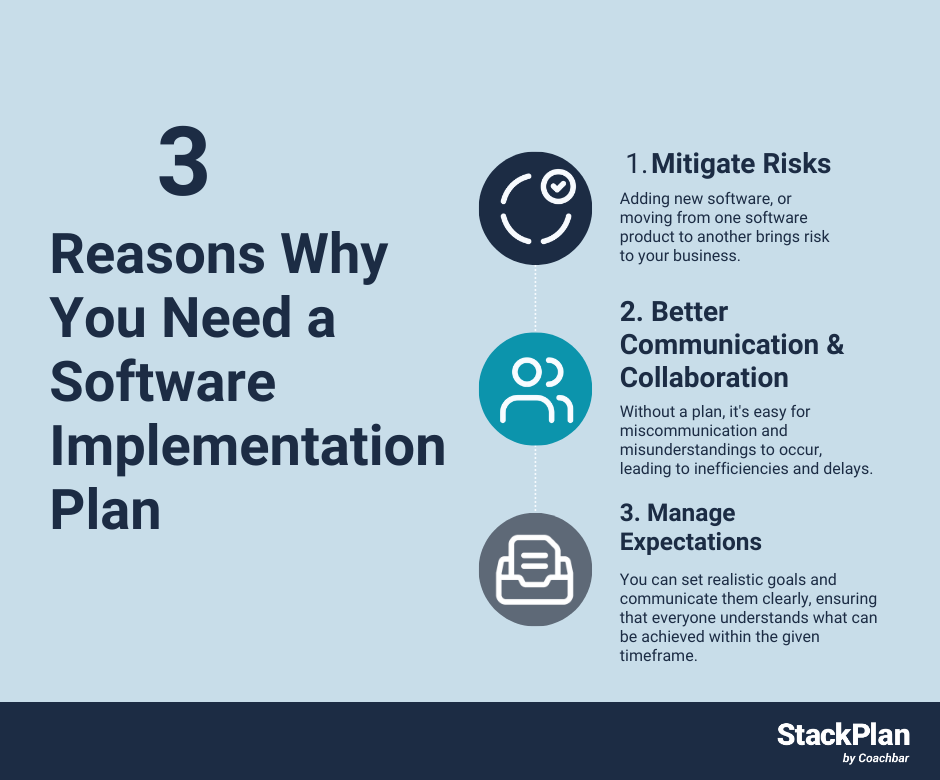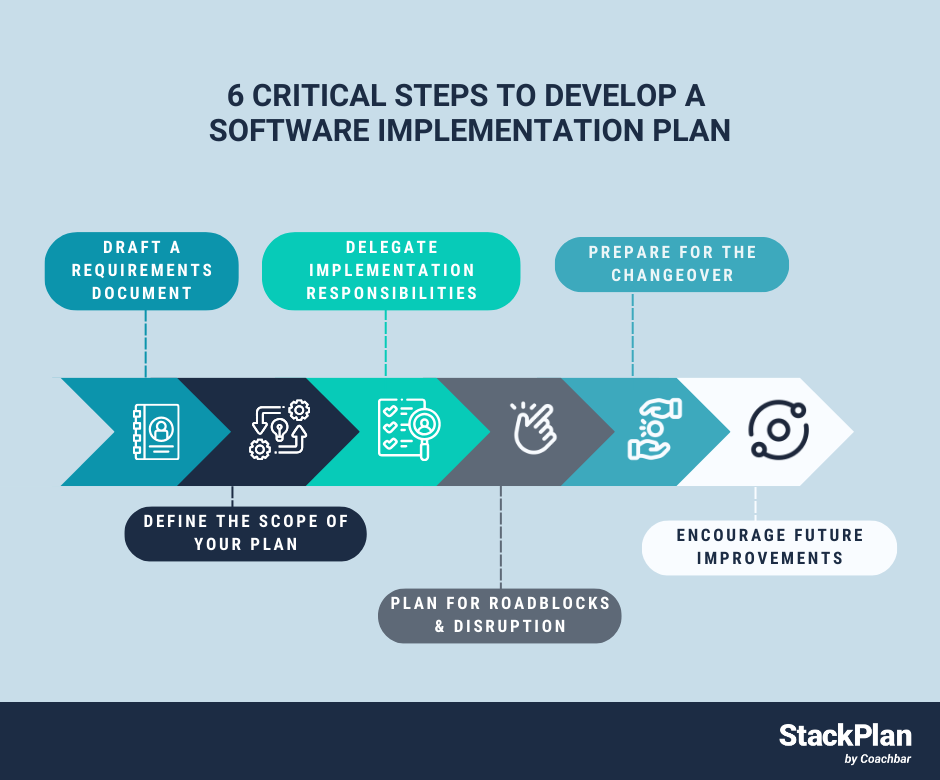You’ve noticed some bottlenecks or inefficiencies in your business and you’ve researched software to help improve those issues. It’s easy to click and buy new software on a provider’s website, but have you thought about creating a software implementation plan? Are you confident that the people in your business will use the software? Will the software share data and workflows with your existing software, as you hope it will? Are you feeling anxious that the software you buy might not achieve results for your business? You’re not alone.
Implementing software is a critical process that requires careful planning and execution. Without a proper plan in place, your business will inevitably face challenges that may result in delays, cost overruns, and even failure of the project.
In this article, we’ll guide you through the steps involved in creating a successful software implementation plan, ensuring a smooth transition and maximizing the benefits of your new software.
Why you need a software implementation plan
Implementing new software involves significant changes to your organization, including processes, roles, and responsibilities. A lack of clear planning that can be communicated easily can jeopardize your software implementation project. These changes can lead to confusion and resistance across teams. People won’t know their roles and responsibilities, what’s expected of them, or understand how the new software supports broader goals.
Ambiguity is the enemy of success. By spending the time upfront to create a well-defined implementation roadmap, and, you’ll set your project up for a smooth transition and optimal outcomes. Software coaches build software implementation plans as the first phase in a project so that the full team knows what to expect.

Mitigate risks
Adding new software, or moving from one software product to another brings risk to your business. Common risks include user adoption issues, integration challenges, budget or timeline overruns, operational slow-downs, and even data loss.
With a well-thought-out implementation plan, you can identify and address potential risks early on. By conducting a thorough risk assessment, you can anticipate any issues that may arise during the implementation process and develop strategies to mitigate them. This proactive approach not only helps to minimize the impact of risks but also increases the chances of a successful implementation.
Better communication and collaboration
Implementing your new software will likely involve multiple departments and individuals working together towards a common goal. Without a plan, it’s easy for miscommunication and misunderstandings to occur, leading to inefficiencies and delays.
Clearly-defined objectives, timelines, and responsibilities in the implementation plan provide a clear framework for collaboration. Team members can easily understand their roles and responsibilities, ensuring that everyone is aligned and working towards the same objectives. This promotes effective communication and coordination, leading to a smoother and more efficient implementation process.
This is especially important when you’re working with a software coach or implementation team to understand what the roles and responsibilities of your internal team members are versus the tasks that will be managed by your partners.
Manage expectations
Stakeholders usually have high expectations for new software, and it’s easy for these expectations to become unrealistic or misaligned.
By clearly outlining the objectives, timelines, and deliverables in the implementation plan, you can manage stakeholders’ expectations effectively. You can set realistic goals and communicate them clearly, ensuring that everyone understands what can be achieved within the given timeframe. This helps to prevent disappointment and frustration, fostering a positive and supportive environment throughout the implementation process.
6 critical steps to develop your software implementation plan
Now that we understand the importance of a software implementation plan, let’s delve into the critical steps for putting one together.

1. Draft a requirements document
The first step in creating a software implementation plan is to thoroughly understand your organization’s requirements.
Conduct a comprehensive analysis of your current systems and processes to identify areas that need improvement or automation.
Once these requirements are identified, document them in a clear and concise requirements document. This document will serve as a basis for evaluating potential software vendors, ensuring that the chosen software aligns with your organization’s needs.
Your requirements document should include a detailed description of the desired features and functionalities, as well as any specific customization or integration requirements. This will help you communicate your expectations to the software vendors and ensure that they can meet your organization’s unique needs.
2. Define the scope of your plan
Defining the scope of your software implementation plan is essential to avoid scope creep and helps you stay focused on your objectives. Clearly outline the goals, deliverables, and milestones that need to be achieved throughout the implementation process.
By setting clear boundaries and understanding the limitations of your plan, you can effectively manage expectations and prevent unnecessary deviations from the original plan. This will help you stay on track and ensure that the implementation stays within budget and timeline. You can also identify the enhancements you want to add in future projects to continue to build on your progress.
This step will also help you allocate resources appropriately and identify any dependencies or constraints that may impact the implementation process.
3. Delegate implementation responsibilities
You’ll need the involvement of multiple stakeholders across various departments and your software coaches, so it’s crucial to delegate implementation responsibilities to the right individuals or teams and ensure that they have the necessary authority and resources to carry out their tasks successfully.
By involving key stakeholders from the beginning, you can foster ownership and buy-in, increasing the chances of a successful implementation. Each team or individual should have clearly defined roles and responsibilities, as well as a clear understanding of how their tasks contribute to the overall implementation objectives.
Hold regular meetings and progress updates to keep everyone aligned and address any issues or concerns that may arise during the implementation process.
4. Plan for roadblocks and disruption
It’s your job to anticipate potential roadblocks and plan for contingencies to minimize their impact on the implementation process. This may include creating backup plans, providing training and support for users, and allocating additional resources if needed. By proactively addressing potential roadblocks, you can minimize downtime and ensure a smooth transition to the new software.
Software consultants or coaches are a great resource to help you plan for roadblocks and disruption because they’ve seen these roadblocks and challenges before.
Don’t forget to communicate the potential impact of the implementation to all stakeholders and manage their expectations accordingly. This will help minimize resistance to change and ensure a more positive reception of the new software.
5. Prepare for the changeover
Create a comprehensive change management plan that encompasses communication strategies, training programs, and post-implementation support. By addressing the concerns and providing ongoing support, you can foster user adoption and minimize resistance to change.
Bonus tip: Involve your end-users in the implementation process from the beginning. This will help them understand the benefits of the new software and provide valuable feedback that can be used to refine the implementation plan and address any usability issues.
6. Encourage future improvements
Software implementation should not be seen as a one-time event but rather as an ongoing process of improvement. As you go through the implementation, gather feedback from users and stakeholders and identify areas for further improvement.
Document lessons learned and use them to refine your processes and strategies for future software implementations. By continuously seeking ways to enhance the software and its implementation, you can ensure that your organization stays ahead in an ever-evolving technological landscape.
It’s important to stay updated with the latest advancements in technology and industry best practices. This will help you identify new opportunities for improvement and ensure that your software implementation remains aligned with the changing needs of your organization. Working with a software implementation specialist can help you build your IT roadmap and keep you up to date with the most recent releases for your software programs.
By following these critical steps and incorporating the additional details provided, you can create a robust and effective plan that maximizes the benefits of the new software and minimizes disruption to your operations.
Simplify software implementation with a software coach or consultant
We’ve simplified software implementation into six key steps, but we know it can still feel like a daunting process. It requires careful planning, coordination, and execution to ensure a successful implementation.
Even if you have created a well-structured software implementation plan, it can still be challenging to execute the plan successfully without the right expertise and guidance.
One way to overcome these challenges is by engaging a software coach. A software coach is an experienced professional who can provide valuable insights, advice, and support throughout the implementation process. They have the knowledge and expertise to guide you in making informed decisions and navigating through any obstacles that may arise. Software coaches have years of experience in implementing software, and have already uncovered the hidden pitfalls and opportunities to streamline the process – making it easier for your project to stay on track.
At Coachbar, our business analysts can help you assess your organization’s specific needs and goals. Then, they’ll connect you with experienced and vetted software consultants who can customize your implementation plan with the necessary steps, timelines and resources required to successfully implement the software.
Throughout the implementation process, the software coach will act as a mentor and advisor. They will be there to answer any questions you may have, provide guidance on best practices, and offer solutions to any challenges that may arise. Their experience and knowledge will help you avoid common pitfalls and ensure a smooth and efficient implementation.
Once your software is up and running, your dedicated coach can also provide training and support to your team. They can conduct workshops or training sessions to familiarize your employees with the new software and its functionalities, ensuring a seamless transition and minimize any disruptions to your business operations.
Our software consultants have worked on numerous software implementations in the past and have encountered various scenarios and challenges. This wealth of knowledge can be invaluable in ensuring a successful implementation.
Check out StackPlan's Directory Today
While creating a software implementation plan is a crucial step, it is equally important to consider the involvement of a software coach. By working with a software coach, you can streamline the process, mitigate risks, and maximize the benefits of your new software.
With their guidance and support, you can drive efficiency, improve productivity, and propel your organization towards long-term success. Check out the StackPlan Directory today to connect with an expert software consultant and get started on executing your software implementation plan.
Need Help Evaluating
your Current Inventory Systems?
Visit our directory of software consultants in the StackPlan Consultant Directory. Vetted consultants are ready to support your business needs.








